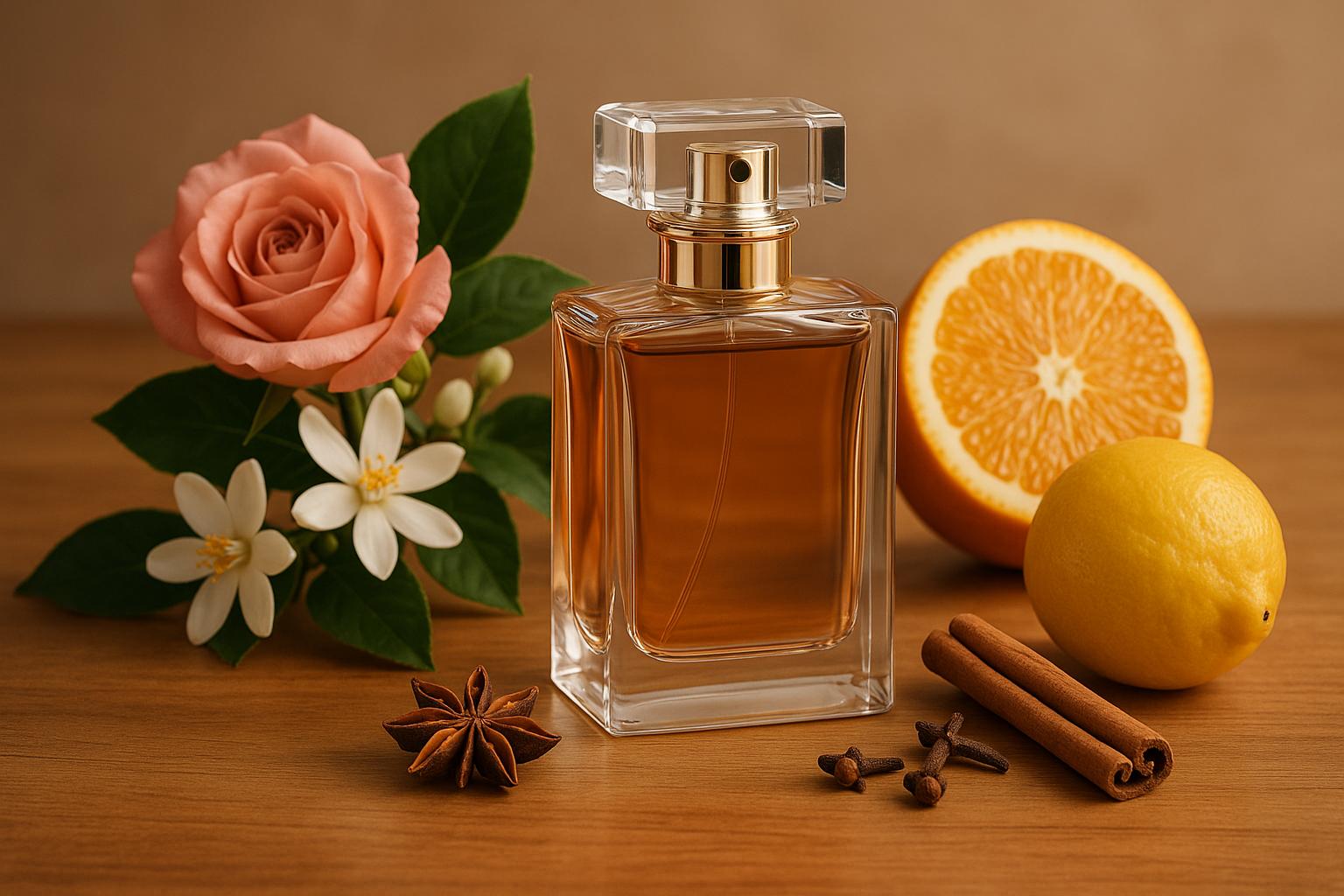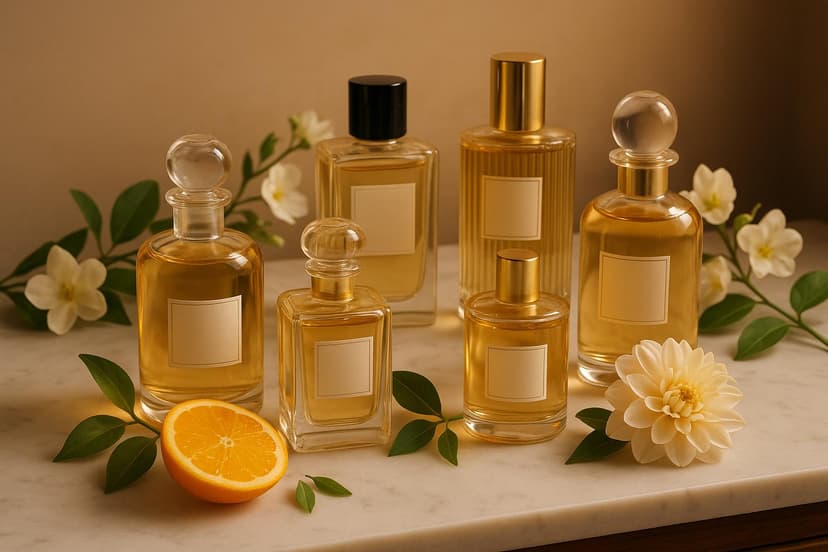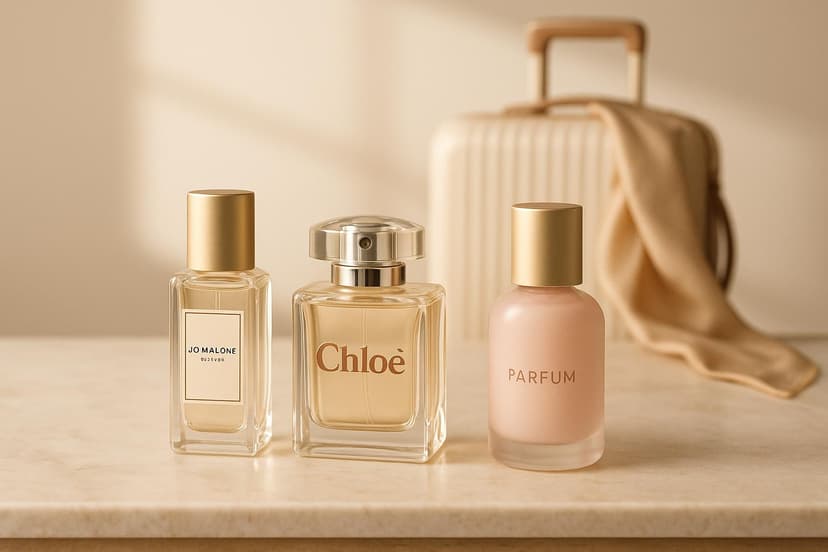Seasonal fragrance blending is about matching your scent to the mood and climate of each season, creating a tailored experience that evolves throughout the year. This guide breaks down the basics of selecting, layering, and rotating perfumes based on weather, temperature, and occasions, ensuring your fragrance always feels just right. Here’s what you’ll learn:
- Seasonal Scent Profiles: Light florals for spring, citrus for summer, spices for fall, and deep, warm notes for winter.
- How Weather Affects Fragrance: Heat amplifies lighter scents, while cold air enhances richer ones.
- Layering Techniques: Combine top, middle, and base notes for a balanced, long-lasting blend.
- Climate Considerations: Choose scents that suit your local humidity, dryness, or temperature swings.
- Practical Tips: Use smaller vials to test seasonal favorites and avoid common blending mistakes like over-layering.
Understanding Seasonal Fragrance Notes
The Role of Fragrance Notes
Every perfume is built on three layers: top notes, middle notes, and base notes. The top notes are your first impression - they deliver a quick burst of scent that lasts around 15–30 minutes, often featuring light, volatile ingredients like citrus oils, herbs, or delicate fruits. Once these fade, the middle notes (or heart notes) take center stage, shaping the core personality of the fragrance for 2–4 hours. These often include florals, spices, or green elements. Finally, the base notes form the foundation, lingering for 6–8 hours or more with deeper, richer elements like woods, musks, and resins.
This layering isn’t just about creating complexity - it’s also key to how a fragrance performs in different weather conditions. Temperature and humidity can alter how these layers develop and interact, making it important to understand how they behave seasonally. A well-crafted fragrance should feel like it belongs in its environment, harmonizing with the season’s natural mood rather than clashing with it.
Seasonal Note Profiles
Each season brings its own unique vibe, and fragrances often mirror these shifts with specific note choices that complement the climate and atmosphere.
Spring is all about renewal and freshness. Fragrances for this season often include green notes like petitgrain, dewy florals such as peony and freesia, and light fruits like pear or apple. These combinations feel airy and optimistic, perfectly matching the gradual warmth of spring without overwhelming the senses.
Summer fragrances, on the other hand, are designed to combat heat and humidity. Bright citrus notes - think bergamot, grapefruit, and lime - offer a cooling effect, while aquatic and marine accords evoke a breezy, refreshing feel. Light white florals like jasmine or orange blossom can add elegance, but heavy, creamy florals are best avoided as they can feel stifling in the heat.
As temperatures drop, autumn fragrances take on a cozier, more grounded character. Warming spices like cardamom, nutmeg, and clove create a sense of comfort, while woody notes such as cedar and sandalwood add depth. Amber and benzoin bring a touch of sweetness, and fruity notes shift to richer options like fig, plum, or cinnamon-spiced apple.
Finally, winter embraces the richest and most indulgent notes. Deep woods like oud, ebony, and patchouli provide warmth, while gourmand elements such as vanilla, chocolate, and caramel feel indulgent and comforting. Incense, frankincense, and myrrh lend a luxurious, enveloping quality that pairs beautifully with the season’s cold, layered clothing.
What’s fascinating about these seasonal profiles is how they can overlap and transition. For instance, a fragrance with citrusy top notes and warm, woody base notes can act as a perfect bridge between summer and fall, adapting seamlessly to changing weather while maintaining its character.
Impact of Climate on Fragrances
Beyond seasonal preferences, your local climate plays a big role in how a fragrance performs. The United States, with its diverse climate zones, offers a perfect example of how geography can influence scent choices.
In humid regions, like the Southeast, heavy and rich notes can quickly become overpowering. The moisture in the air amplifies fragrance molecules, making scents feel stronger and last longer. On the other hand, dry climates - such as those in Nevada or Arizona - have the opposite effect. Fragrances tend to evaporate faster, making them feel sharper initially but requiring reapplication or stronger base notes to maintain their presence throughout the day.
Regions with temperature swings, like Chicago or Denver, present their own challenges. A fragrance that feels balanced in a warm car might become too intense in the cold or lose its impact in a heated room. Similarly, altitude affects how scents behave. At higher elevations, thinner air can reduce a fragrance’s projection, which is why people in cities like Denver or Salt Lake City might prefer stronger concentrations or more potent note combinations to counteract this effect.
Understanding these factors helps you make smarter fragrance choices. For instance, someone living in Phoenix’s dry heat will have completely different preferences than someone in Seattle’s humid, temperate climate - or someone in Minneapolis, where the seasons vary dramatically.
To find the perfect match for your environment, try sampling scents with Scento’s 8ml vials. These smaller sizes are ideal for testing how fragrances like Tom Ford or Dior perform in your local climate across different seasons before committing to a full bottle.
Techniques for Layering and Blending Seasonal Scents
Step-by — Step Layering Guide
Layering fragrances is an art that lets you create a scent uniquely yours. The secret lies in understanding how different notes interact and applying them in a thoughtful sequence.
Start by applying your base notes - these are the foundation of your blend. Dab them on pulse points like your wrists or behind your ears. Next, introduce the middle notes in a slightly different area, such as your inner elbows or the base of your throat. This creates depth without overwhelming any single spot. Finish with the top notes, the lightest and most fleeting elements. A quick spritz on your clothing or a dab on your collarbone is enough. Be patient - allow 10-15 minutes between each layer so the scents can settle and reveal their character.
Before committing to a combination, test it thoroughly. Start with blotter strips or try blending fragrances on your wrist to see how they interact. Then, test directly on your skin to ensure the blend works with your natural oils and pH. Let the combination develop for at least 30 minutes to understand how it evolves over time.
Remember, when it comes to layering, less is more. Begin with two fragrances and perfect that pairing before introducing a third. Most successful blends involve no more than three scents - any more, and the result can feel muddled, losing the individuality of each fragrance.
Seasonal Layering Ideas
The changing seasons are a fantastic guide for experimenting with scent combinations. Each season brings its own mood and palette of notes to explore.
Spring is perfect for light, airy combinations. Pair soft florals like peony or freesia with fresh green notes such as petitgrain or grass. This mix captures the essence of renewal and freshness. For a more neutral vibe, try blending bright citrus top notes like bergamot with gentle woody bases like cedar or sandalwood.
Summer calls for crisp, refreshing scents that won’t overwhelm in the heat. Citrus and aquatic notes are natural allies - combine grapefruit or lime with marine or sea salt accords for a breezy, cooling effect. White florals such as jasmine can also work beautifully when paired with lighter woods, though it’s best to avoid overly creamy or heavy elements.
Fall invites richer, cozier blends as the weather cools. Spices like cardamom or nutmeg pair wonderfully with warm woods like cedar or sandalwood, creating a comforting yet grounded feel. Amber-based scents can also shine here, especially when combined with subtle gourmand touches like vanilla or fig.
Winter is the time to embrace deep, luxurious scents. Rich woods like oud or patchouli pair seamlessly with gourmand elements such as vanilla or chocolate for an indulgent, warming effect. Incense-based fragrances layered with amber or resins create sophisticated blends that are perfect for cold days and festive gatherings.
For a smooth transition between seasons, try a blend that balances contrasting elements. For example, a light citrus top note with a warm, woody base can carry you from late summer into early fall, adapting effortlessly to the changing weather.
Adapting Scents for Different Occasions
Layering techniques should also be adjusted based on the setting and occasion to ensure your fragrance feels appropriate and performs well.
Day vs. Night: For daytime, especially in professional settings, go for lighter, more subtle combinations. Use fewer sprays and stick to understated blends like a clean floral paired with fresh notes. Reserve more intense, layered experiments for evenings or weekends when you can be bolder with your choices.
Indoor vs. Outdoor: Indoor spaces, especially those with controlled temperatures, can amplify fragrances, so apply your scents sparingly and focus on close-to-skin application points. Outdoors, where wind or humidity can disperse scents more quickly, consider slightly stronger base notes or a more generous application to maintain presence.
Seasonal Events: Tailor your layering to the occasion. For summer barbecues or beach outings, stick to light, fresh combinations that won’t clash with food or feel overpowering in the heat. Winter holiday parties, on the other hand, are ideal for showcasing rich, complex blends that match the season’s festive atmosphere.
Climate Matters: Humidity can intensify and prolong scents, so use fewer sprays in such environments. In dry climates, you might need to reapply throughout the day or focus on fragrances with longer-lasting base notes to keep your blend intact.
If you’re hesitant to commit to full-size bottles, Scento’s 8ml vials offer the perfect solution. These smaller sizes let you experiment with layering combinations from brands like Dior or Tom Ford, helping you discover what works best for your lifestyle and climate before investing in a full bottle.
Selecting and Sourcing Seasonal Fragrance Notes
Choosing Harmonious Notes
Crafting the perfect seasonal fragrance starts with selecting notes that resonate with the climate and mood of each season.
For spring, think of light and fresh scents that capture the season’s sense of renewal. Florals like peony, orchid, cherry blossom, and lily of the valley work beautifully. Add green accents such as fresh leaves or green tea, and balance everything with soft fruity hints like pear and a touch of musk.
In summer, the focus shifts to vibrant and refreshing notes that stand up to the heat. Citrus elements like bergamot pair wonderfully with aquatic or marine tones. Delicate white florals, such as jasmine or tuberose, when used lightly, evoke a breezy, sunlit atmosphere.
Fall invites richer, cozier combinations. Warm spices like cinnamon, nutmeg, and cardamom bring a sense of comfort, while woody notes like cedar and sandalwood provide depth. Amber can act as a bridge, connecting the lighter remnants of summer with the deeper, more robust scents of winter.
For winter, it’s all about luxurious intensity. Deep woods like oud and patchouli pair seamlessly with gourmand notes like vanilla, chocolate, and honey. Adding incense or resinous layers can enhance warmth, creating a cocoon-like effect against the cold.
By aligning your fragrance notes with the changing seasons, you can create a collection that feels fresh and perfectly suited year-round.
Refresh Your Collection Seasonally
Once you’ve identified the right notes, it’s important to rotate your fragrance collection to keep things interesting and avoid scent fatigue.
Each season, review your collection and set aside fragrances that align with the upcoming weather. Test your chosen scents in real-life conditions to ensure they perform as expected. Take note of successful pairings to guide future selections.
Instead of revamping your entire collection every season, consider thoughtful, strategic additions. This approach helps you maximize each fragrance’s impact while deepening the emotional connection between scent and memory.
Discovering Scents with Scento

Traditionally, building a seasonal fragrance wardrobe meant committing to full-size bottles that often went unused. Scento offers a smarter solution with 8ml vials of luxury fragrances, delivering around 120 sprays per vial - perfect for exploring scents without the long-term commitment.
Scento’s monthly subscription allows you to refresh your collection effortlessly. Choose scents tailored to the season or let their personalized recommendations guide you. With a catalog of over 900 designer options, including Dior, Tom Ford, and Louis Vuitton, there’s something for every preference.
Whether it’s fresh florals for spring, zesty citruses for summer, warm spices for fall, or rich woods for winter, these travel-friendly vials let you carry multiple seasonal options. It’s an easy way to stay on trend without the hefty price tag of full-sized bottles, which often range from €100 to €300.
FALL SCENTS 101: HOW TO LAYER LIKE A PRO 🍂
sbb-itb-fb213bc
Common Mistakes in Fragrance Blending and How to Avoid Them
Creating a balanced and harmonious fragrance blend is as much an art as it is a science. Even seasoned fragrance lovers can stumble into common pitfalls. Knowing what to avoid can save you from wasting precious product and ending up with a mix that doesn’t meet your expectations.
Avoid Over — Layering
One of the most frequent missteps is assuming that more scents automatically lead to a better result. When too many fragrances are layered, they often clash instead of complementing one another, creating an overpowering aroma that can quickly lead to scent fatigue.
Over-spraying doesn’t just waste your favorite perfumes - it also dulls your ability to assess how the blend is coming together. A smarter approach is to start small. Choose two fragrances that complement each other. Begin with a lighter, more subtle scent as your base and carefully layer a stronger, accent fragrance on top. The order of application matters: applying the lighter scent first ensures the more intense one enhances the blend instead of overwhelming it.
Watch for Clashing Scent Families
Blending fragrances without considering their scent families is like mixing clashing colors on a canvas - you could end up with a chaotic and unbalanced result. While certain scents may smell fantastic on their own, not all of them play well together.
For instance, sharp or harsh notes paired with overly sweet gourmand fragrances can create a jarring and unpleasant combination. Instead, focus on pairing fragrance families that naturally complement each other. Fresh florals often work beautifully with citruses and herbals, while woody notes pair well with spices and resins. Balance is key: combining a bold, projection-heavy scent with a delicate fragrance requires careful consideration to avoid overpowering the blend.
Don’t forget that context plays a role too. A combination that feels cozy and inviting on a winter evening might come across as too heavy and cloying on a warm summer day. Think about when and where you plan to wear your blend, and adjust your choices accordingly. Once you’ve layered your fragrances, give them time to settle and fully develop on your skin.
Let Blends Settle
Patience is essential when experimenting with fragrance blending. One common mistake is judging the result too quickly after application. Fragrances need time to interact with your skin’s natural chemistry - its pH, temperature, and natural oils - to reveal their true character. What might seem sharp or unbalanced at first can transform into a beautifully cohesive blend after 15–20 minutes.
It’s also important to test blends directly on your skin rather than on paper strips or clothing. Your skin plays a crucial role in how the fragrance evolves. Additionally, don’t overwhelm your senses by trying too many combinations at once. This can lead to nose fatigue, making it hard to evaluate each blend properly. Stick to a few experiments at a time and allow each blend enough time to settle before making your final judgment.
Transitioning Your Fragrance Wardrobe Through the Seasons
Shifting your fragrance wardrobe with the seasons isn’t just practical - it can completely transform how you experience scent. Warmer months amplify how fragrances project, making airy, lighter options perfect for spring and summer. Meanwhile, colder weather tends to mute scent molecules, creating the perfect stage for richer, more intense aromas to shine.
Making these transitions smooth and enjoyable requires a bit of strategy. Let’s dive into how transitional notes and thoughtful adjustments can help you ease into each seasonal shift.
Using Transitional Notes
Seasonal transitions can feel seamless when you incorporate transitional notes into your fragrance choices. These notes act as bridges, helping your senses move naturally from one seasonal vibe to the next.
For example:
- Spring to Summer: A blend of jasmine and bergamot can capture the freshness of spring while hinting at the sunlit warmth of summer.
- Summer to Fall: Think warm spices paired with soft fruity notes, like cardamom layered with fig or pear, to echo the cozy yet crisp essence of early autumn.
- Fall to Winter: Scents that combine autumnal woods with the comforting warmth of vanilla or amber are perfect for the colder months.
- Winter to Spring: Gentle florals mixed with light woody undertones - like rose with cedar or peony with soft musk - signal the renewal of spring.
The concentration of your fragrance is just as important as the notes themselves. In warmer months, lighter formulations like Eau de Toilette or Eau de Cologne feel refreshing, while cooler weather calls for the depth and staying power of Eau de Parfum or Parfum. This way, you can enjoy your favorite scent families year-round by simply adjusting their intensity.
Another tip? Gradual transitions can help your senses adjust. Instead of jumping straight from a winter-heavy vanilla to a bright summer citrus, try a fragrance that blends elements of both. This approach creates a smoother, more harmonious shift.
Leveraging Scento for Seasonal Updates
Navigating seasonal fragrance changes can be tricky, especially when full-size bottles are involved. A rich winter scent often feels out of place in summer, and a light summer fragrance can get lost in the chill of winter. That’s where Scento steps in.
Scento’s monthly subscription service offers a smart, flexible way to explore seasonal scents without committing to full-size bottles. For just €14.99 per month, you’ll receive 8ml travel-friendly vials - roughly 120 sprays, enough to last a month. With access to over 900 designer fragrances from top brands like Dior, Tom Ford, and Louis Vuitton, you can experiment with different scents as the seasons change.
This model is perfect for urban micro-seasonal wardrobing, where your fragrance needs can vary by occasion. Whether you’re looking for a crisp, professional scent for the office, a romantic floral for date night, or a zesty citrus for weekend outings, Scento makes it easy to refresh your scent wardrobe throughout the year.
Even better, Scento’s personalized recommendation system learns your preferences over time, suggesting fragrances that align with your seasonal and personal style. With a 30-day money-back guarantee and the flexibility to cancel anytime, you can adapt your subscription to match your evolving tastes and seasonal needs.
Conclusion: Mastering Seasonal Fragrance Blending
Seasonal fragrance blending is all about aligning your scent with the rhythm of the seasons, creating a sensory experience that evolves throughout the year. By understanding the art of note selection and layering, you can build a fragrance collection that feels personal and dynamic, adapting effortlessly to the changing weather and your everyday moments.
The key to successful blending lies in knowing how different notes interact to create depth, balance, and lasting impressions. Starting with harmonious base notes ensures a smooth foundation, helping you avoid common pitfalls like overpowering layers or mismatched scent families. This thoughtful approach doesn’t just enhance your scent - it allows you to craft meaningful olfactory moments that echo the essence of each season.
Scento makes this journey even more accessible. With their 8ml monthly vials, you can explore a curated selection of over 900 designer fragrances, perfect for experimenting with seasonal combinations. This lets you try new blends without committing to full bottles, keeping your collection fresh and inspiring as the seasons shift.
Each season offers a fresh opportunity to refine your craft. By consistently applying these techniques, you can evolve your fragrance wardrobe into a reflection of your unique style and the world around you.
FAQs
How do I pick the right fragrance notes for my local climate when blending seasonal scents?
When selecting seasonal fragrances, it’s important to think about how your local climate influences the way scents are perceived. In warm, humid weather, fresh citrus, green, and aquatic notes shine because they feel crisp and invigorating. On the other hand, colder seasons call for richer, spicier, or woody notes, which bring a sense of coziness and depth to your fragrance.
Lighter, breezy scents are perfect for the heat, as they won’t feel overpowering, while bold, long-lasting fragrances are better suited for chilly days, offering both comfort and durability. Matching your fragrance to the season not only enhances its appeal but also creates a more harmonious and enjoyable experience.
What mistakes should I avoid when layering fragrances for different seasons?
When layering fragrances for different seasons, it’s important to avoid overdoing it. Combining more than two scents can overwhelm your senses and muddle the overall effect. Instead, aim for a harmonious blend where the notes enhance each other rather than compete. For example, pairing a rich gourmand with a delicate floral might feel disjointed - unless there’s a middle note that ties them together seamlessly.
Seasonality plays a key role in fragrance choices, too. During warmer months, lighter and fresher scents tend to work best, as heavier blends can feel overpowering in the heat. On the other hand, richer, deeper fragrances shine in colder weather, where they can fully develop and linger beautifully. Always keep in mind how temperature and environment influence how a scent unfolds and interacts with your skin.
How can I update my fragrance collection for each season without buying full-sized bottles?
To update your fragrance collection with the seasons without investing in full-sized bottles, consider using travel-sized vials or sample sets. These smaller options let you explore scents that match the season and even experiment with layering - a fun way to create personalized blends or adjust a fragrance’s intensity to fit the weather.
Proper storage is key to keeping your perfumes in top condition. Place them in a cool, dry spot, away from direct sunlight or extreme temperatures, to preserve their quality. When introducing new scents, ease into it by starting with just one or two fragrances. This gradual approach makes the shift feel natural and aligns with your changing preferences.




